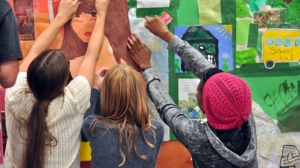The benefits of cooperative learning in the classroom have shown to positively affect academic success in multiple ways. Assigning students to work in groups rather than individually offers a learning arena that can help to develop their personal attitudes, values and social skills. By exchanging knowledge and information with others, students are forced to learn about alternate or opposing viewpoints. While the role of the teacher may appear to have faded as student to student interaction takes the spotlight, the teacher’s role may be more important than before as they are acting as a facilitator to ensure the groups act respectfully while staying focused on the learning task. Borich (2011) outlines the appropriate steps to establishing cooperative task structure:
1. Specify the goal: identify the product or behavior that is expected by the end of the lesson
2. Structure the task: create groups that are equally and fairly divided by gender, age and learning ability. Decide how much time will be spent on the collaborative learning task and assign necessary roles. Offer reinforcement and rewards (i.e. grades, privileges)
3. Teach and evaluate the process: show the class how to appropriately collaborate with peers
4. Monitor group performance: observe and intervene during the process to ensure the group has understood their goal
5. Debrief: Provide feedback to the groups and discuss openly with the class how the process went and what viewpoints they learned from
As I prepare to teach high school Health, I can appreciate the benefits of using a collaborative learning approach for specific lessons. Using the Washington State EALR’s as a drawing board, here is an example of a GLE that would be appropriately met if a collaborative learning approach were used.
EALR: The student acquires the knowledge and skills necessary to maintain a healthy life: Recognizes dimensions of health, recognizes stages of growth and development, reduces health risks, and lives safely.
GLE 2.1.1
- Critiques health and fitness data to make predictions and recommendations for lifelong wellness
- Example: Understands that limited flexibility could predict back problems in
adult life. Recommendation is to develop stretching routine to prevent back problems.
Under this GLE, students are expected to think critically about health and fitness in terms of lifelong wellness. To tackle this learning expectation, I would introduce the lesson’s objective and explain the structure of collaborative learning, allowing them to ask questions before being split into learning groups. After hand-selecting groups that fairly divide students by their age, gender and learning level, I would explain their time limits and repeat their goal and the expected outcome. Using collaborative learning for this specific lesson could greatly benefit students as it provides them with an opportunity to share pieces of their cultural background and beliefs allowing for potential growth around their idea of what a healthy lifestyle is. By allowing students to collaborate on what healthy means in their own families, students are not only developing new attitudes towards lifelong wellness, but also developing new respect for their classmates.
Sources:
Borich, G. D. (2011). Instructor’s copy Effective teaching methods: research-based practice (7th ed.). Boston, MA: Pearson.
OSPI Washington State Health and Fitness Learning Standards http://www.k12.wa.us/HealthFitness/Standards.aspx

